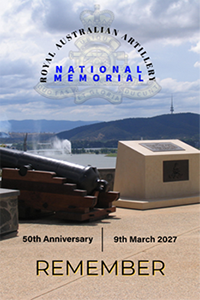|
||||||||||||||||||||||||||||||||||||||||||||||||||||||||||||||||||||||||||||||||||
| Have a Question / Feedback ? | Submit | Search Our Site |
|
| ACTION! ACTION! ACTION! Book Reviews |
||||
 |
||||
| Emeritus Professor David Horner AM, Australian National University | ||||
This new book, published under the auspices of the Royal Australian Artillery Historical Company, is in the style of the Australian Army History Unit’s successful campaign series. It is lavishly illustrated with photographs and maps, has ‘breakout’ pieces on prominent artillery personalities, and sections on artillery tactics and technology. Substantial appendixes cover artillery organisations over a hundred years. Written by two experienced gunners, Lieutenant Colonel Nicholas Floyd and Major General Paul Stevens, assisted by members of the Artillery Historical Committee, the book seeks to condense the history of Australian artillery over 150 years into just over 200 pages. It keeps its focus firmly on the employment of artillery rather than on the experiences of the gunners, except for the sections on individual gunners. The book is targeted primarily at aspiring professional gunners. In 1995 (almost 30 years ago) I published my history of Australian artillery called The Gunners, and although the regiment had a distinguished record of service in two world wars and Vietnam, I struggled in vain to conclude the book on a high note. At that time, the Army and the artillery were in the doldrums. Following government policy, the Army focused on dealing with the (unrealistic) threat of low-level incursions into northern Australia. Even the Australian infantry battalion on a peace enforcement mission to Somalia in 1993 did not require the support of a gun battery. This new history brings the story up to 2021, and it reveals that Australian Artillery has been transformed. It is true that gun batteries have still not been deployed on operations. In East Timor in 1999, as in Somalia, artillery provided civil-military teams, as well as deploying field batteries as infantry. However, in Iraq and Afghanistan the artillery deployed staff for Joint Offensive Support Coordination Centres, target acquisition radars, uncrewed aerial vehicles and Joint Offensive Support Teams. Australian gunners directed fire from Allied air forces, artillery and mortars. Some Australian gunners served in British Army batteries. As the book makes clear, this was just the first step in the revitalisation of Australian artillery in the decade after Australia formally withdrew from Afghanistan in 2014 and China emerged as a threat. The Russia-Ukraine and Armenia-Azerbaijan conflicts showed the key role of drones in modern warfare, and the first conflict continues to demonstrate the critical importance of field artillery and long-range missiles. Advised by military experts, the Australian government assessed that the Defence Force had to be able to compete in this environment of potential war. As a result, the Royal Australian Artillery has emerged at the forefront of the Army’s modernisation program. With long-range missiles, self-propelled artillery, modern conventional and precision ammunition, improved drones, advanced air defence capabilities, and new digitised artillery command and control systems, the Artillery is returning to a more central position within the Defence Force’s joint force capabilities. In response, the Historical Company believed that a concise history of the regiment, produced as a digestible, easy-to-read book, would provide a valuable foundation for the education of a new era of gunners. The book fills this aim admirably. New gunners will learn that their regiment has had celebrated history and continues to be the king of the battle. With the need to condense much into a short space, there is little description of what it was like to serve as a gunner in the various conflicts. The book also has several errors. For example, the rank of brigadier general was abolished in the Australian Army in the 1920s, so all the many references to brigadier generals in the Second World War need to be amended. And there are some slight errors in the tactical details of some World War II campaigns. These errors do not detract from a most attractive, imaginative and valuable history of the employment of Australian artillery over its 150-year history. |
||||
Everywhere Whither Right and Glory Lead |
||||



